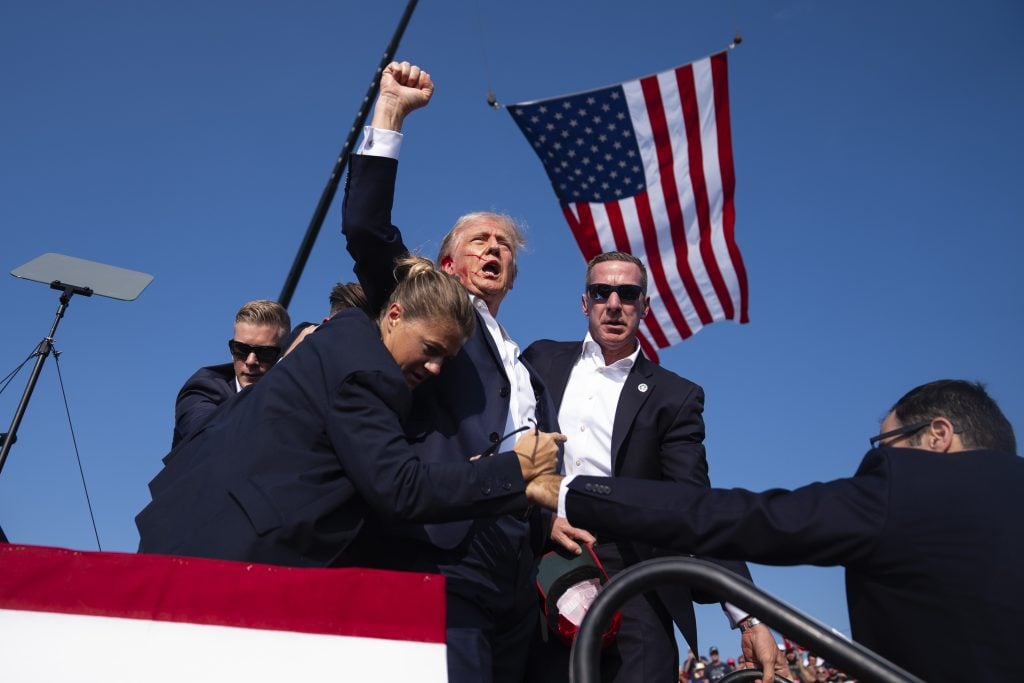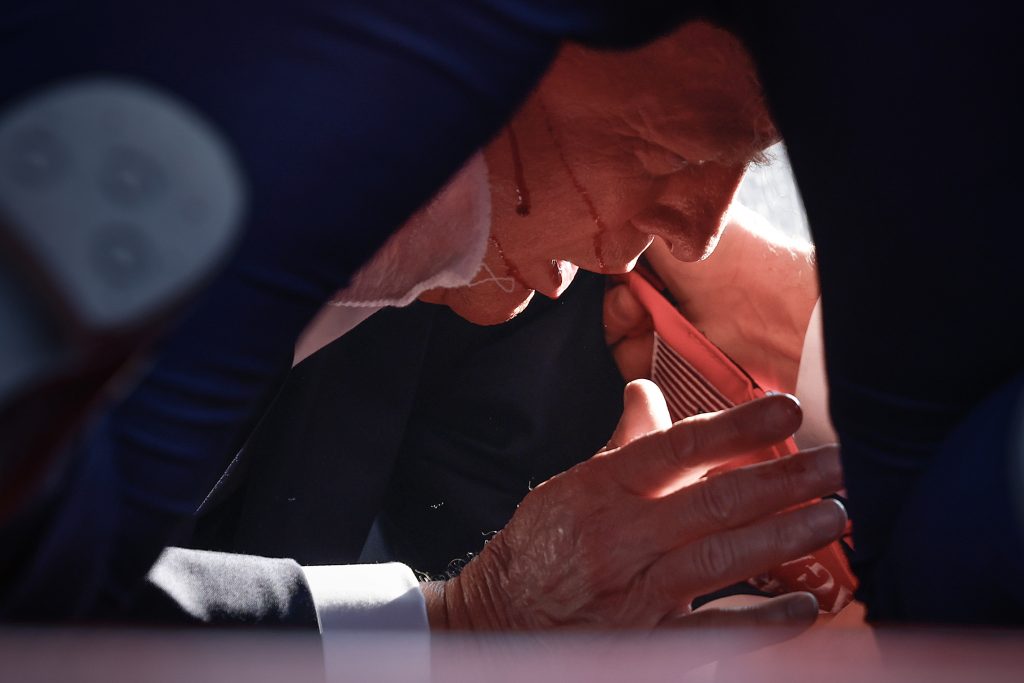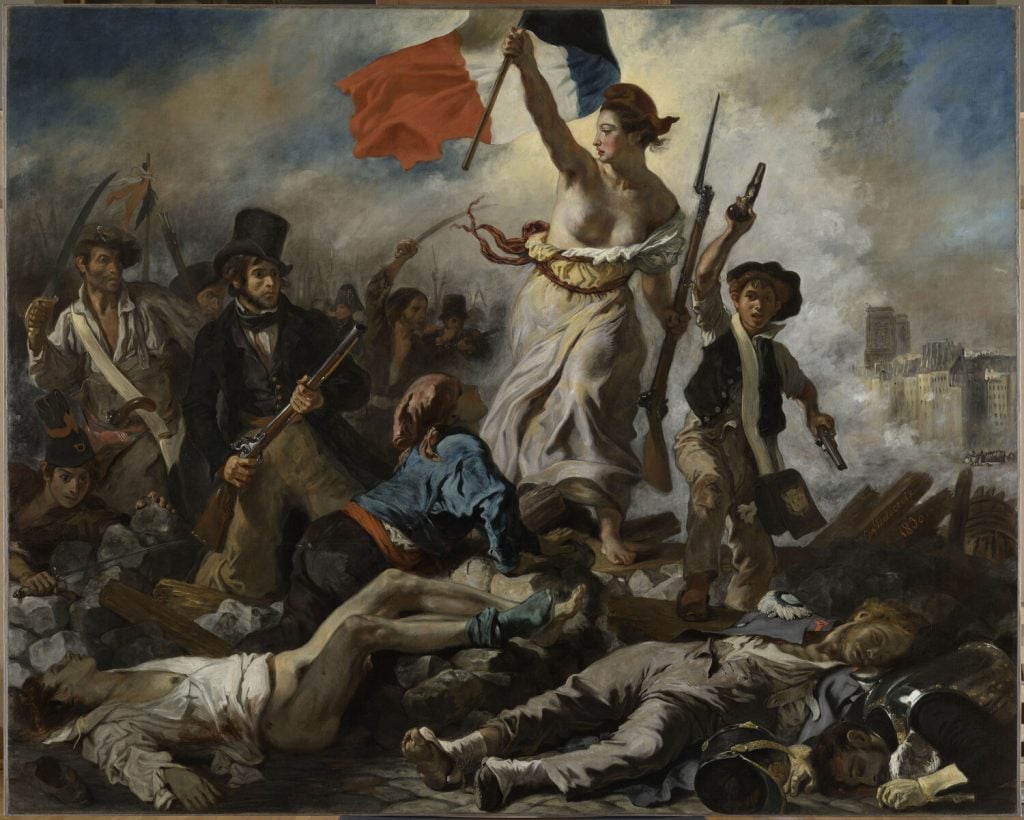Law & Politics
Is It Dangerous to Celebrate the Artistic Merits of Trump’s Photo?
Two people were killed, including the shooter, and two other people were injured in the apparent assassination attempt.

Two people were killed, including the shooter, and two other people were injured in the apparent assassination attempt.

Margaret Carrigan

In the mere seconds following the gunfire aimed at Donald Trump at a Pennsylvania campaign rally on Saturday, photographers could be seen rushing the sides of the stage to capture the unfolding assassination attempt on the former president as the rest of the crowd took cover. The resulting images have swept the globe, inspiring shock and disbelief, awe and dismay. Moreover, they have also underscored the indelible power of a well-constructed picture.
A photo by Associated Press (AP) photographer Evan Vucci has quickly come to define not just the incident—which killed two, including the shooter, identified as 20-year-old Thomas Matthew Crooks, and critically injured two others—but the presumed trajectory of the presidential campaign. It features a bloodied Trump punching his fist into the air as Secret Service agents surrounded him and rushed him from the stage while he shouted “Fight! Fight! Fight!” to his supporters. It has been billed by Washington Post art critic Phillip Kennicott as an image that “can change America forever.”
It is rare that an arts writer is tapped to weigh in on political news and violent crime, so why has this image inspired so many leading art critics and major news outlets to analyze the merits of its composition rather than the events that transpired?
Though several photographers took similar images, Vucci’s “will become the definitive photo from the attempt,” Patrick Witty, a former photo editor at Time, The New York Times, and National Geographic, said in comments to AP.
“It captures a range of complex details and emotions in one still image—the defiantly raised fist, the blood, the agents clamoring to push Trump off stage and, most importantly, the flag,” he said. “That’s what elevates the photo.”

Republican presidential candidate former President Donald Trump is shown covered by U.S. Secret Service agents after an apparent assassination attempt during a rally on July 13, 2024 in Butler, Pennsylvania. Photo by Anna Moneymaker/Getty Images.
Vucci’s technical expertise is evident. A former combat photographer who has covered conflict in Iraq and Afghanistan, he told CNN he immediately knew the pops he heard at the rally were gunfire. He rushed the stage to Trump’s right but his view was blocked by Secret Service agents.
“I’m looking through the viewfinder and I’m thinking, ‘OK, what’s my light? Where’s the composition?’ I’m telling myself, ‘Slow down, slow down, frame, compose’—all the things that photographers tell themselves,” Vucci said. “It’s so important in that moment not to just slam on the motor drive just to hope you can get something. You’ve got to continue to make photos. You’re not taking photos. You’re making them.”
The art world personality Hilde Lynn Helphenstein, better known as Jerry Gogosian, called Vucci’s photograph a “compositional masterpiece” and admitted to hating “how amazing this photo is” in an Instagram post. Along with an annotated version of the AP image, she noted that the weight of the American flag in the background is balanced with the weight of a Secret Service agent in the photo and that “the eyeline of each Secret Service agent is on the rule of thirds grid almost perfect.”
Art historian Carrie Scott was also among those in the art world who analyzed the photographs of the attempted assassination. She likened Vucci’s photograph of Trump with his fist in the air to the raising of the flag at Iwo Jima, a photo taken by Joe Rosenthal in 1945. That picture “became a symbol of hope and perseverance” after World War II and Vucci’s photo “has the potential to be just as famous” for portraying Trump as an “invincible leader,” she said.
On top of comparisons to historical photojournalism, the images from Saturday have been likened to historical paintings, such as Eugène Delacroix’s Liberty Leading the People (1830), which commemorates the July Revolution of 1830 that toppled King Charles X. It’s worth noting, however, that while this painting reflects something real in history, it is allegorical not documentary.

Eugène Delacroix, Liberty Leading the People (1830), after restoration. © Grand Palais Rmn (Musée du Louvre) / Adrien Didierjean / Mathieu Rabeau.
This seemingly blurred line between myth and reality as captured in the AP photo may be why it has inspired so much attention for its artistry. Yet as New York Times art and culture critic Jason Farago points out, there is a moral matter at stake in divorcing the image from the incident.
“I have always bridled against the temptation to treat images of suffering… as objects of aesthetic judgment,” Farago wrote. “And analogies like these underestimate a larger change in how we encounter images today, where even the most ‘iconic’ picture is something mutable and unfixed.”
In the aftermath of the shooting, concerns have grown about potential acts of violence from both ends of the political spectrum. While Democrats have claimed that Trump incited the attack on the capital on January 6, 2021, Republicans blame the mass media for stoking public tension amid the current campaign. For example, the conservative New York Post blasted Democrats’ comparisons of Trump to Adolf Hitler as a contributing factor to Saturday’s violence. Meanwhile the former president’s son, Donald Trump Jr., claimed comparing his father to a “dictator” was the “main message” of President Joe Biden’s campaign, leading political observers to call for the de-escalation of campaign rhetoric.
Regrettably, the artistic celebration of Vucci’s image may only prove an escalation.
“Densely packed with markers of nationalism and authority—the flag, the blood, the urgent faces of federal agents in dark suits—it will encourage some of the darkest forces in American civic life,” Kennicott wrote in the Washington Post. “People who preach violence, who revel in its political potential, can now say that one of their own is a victim, and he was. From that, more cycles of violence are almost inevitable.”
Adam Schrader contributed reporting.